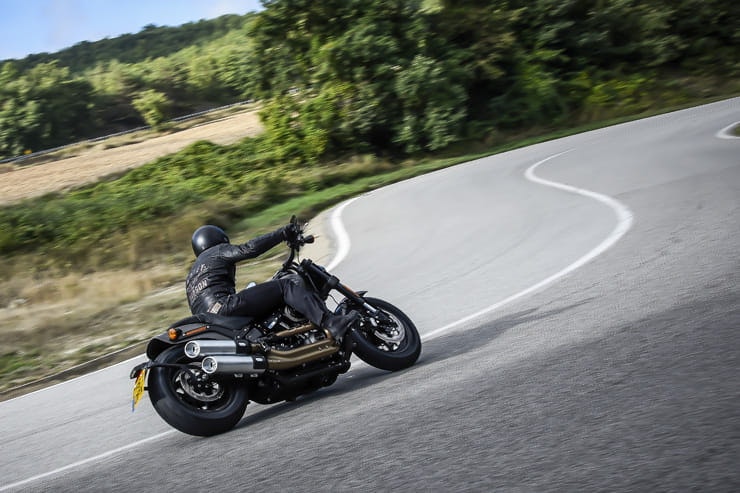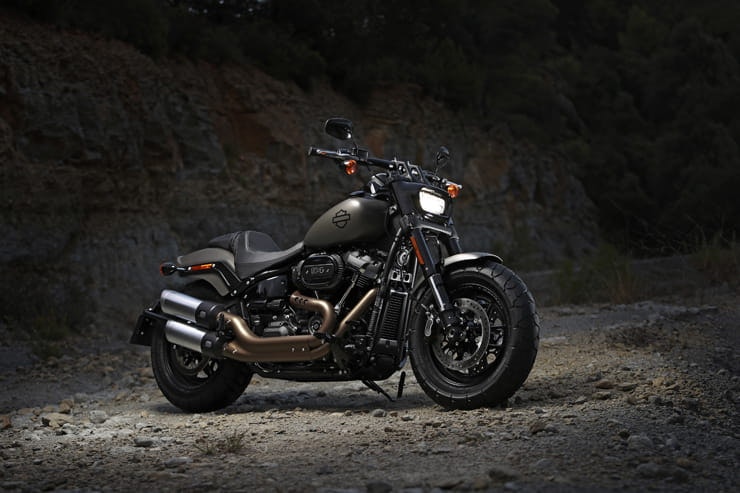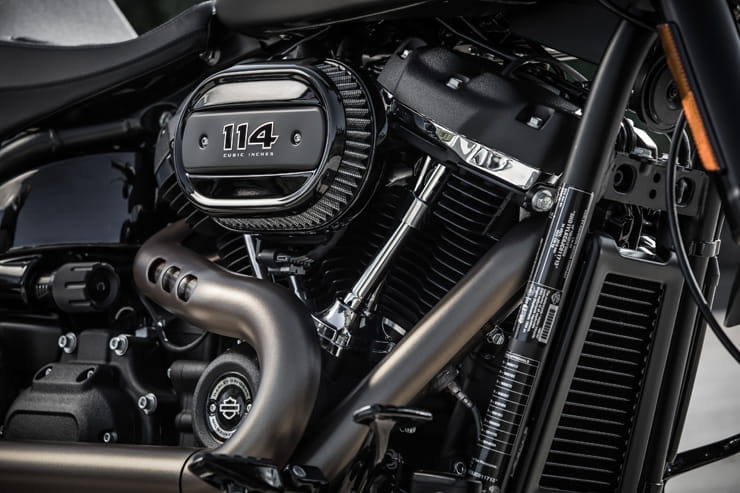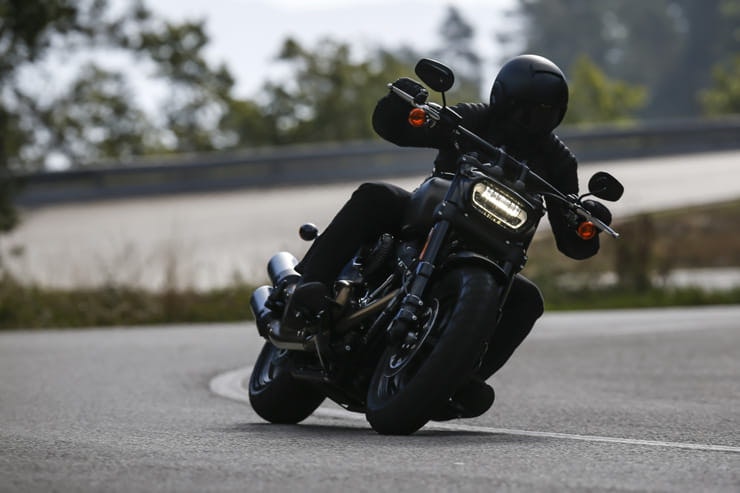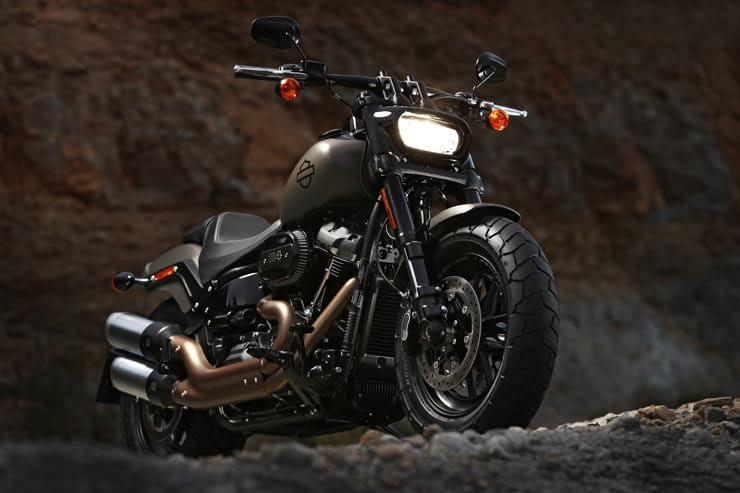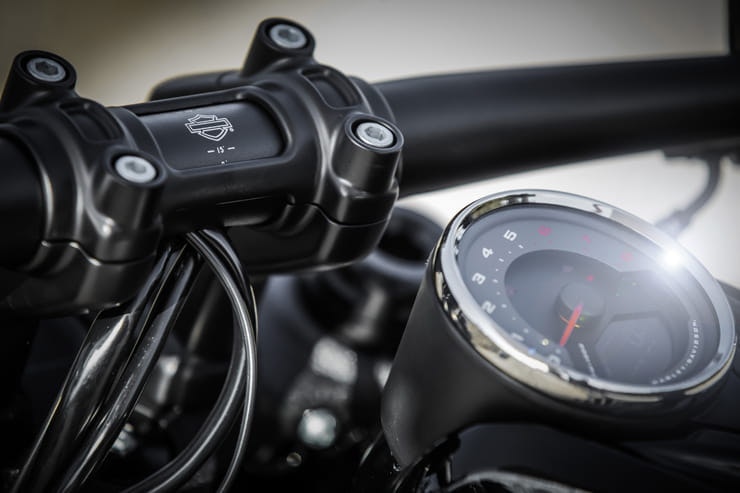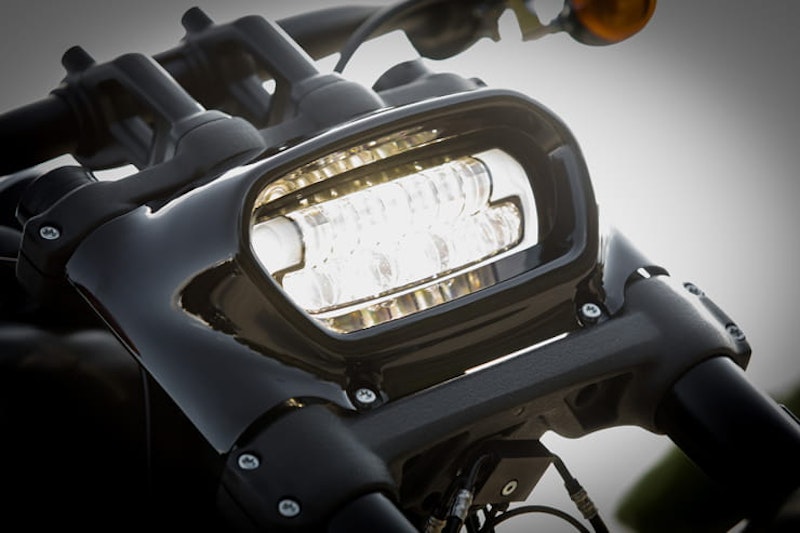Harley-Davidson Fat Bob (2018) - Review
BikeSocial Road Tester. As one half of Front End Chatter, Britain’s longest-running biking podcast, Simon H admits in same way some people have a face for radio, he has a voice for writing.
26.09.2017
Harley-Davidson are, literally, a breed apart. The rest – Honda, Kawasaki, BMW, Triumph etc – all make motorbikes. But Harley only build Harleys; not even rival US V-twin cruisers get close. Among the public, Harley is almost a generic noun for ‘motorbike’. Your mum’s heard of them.
And that kind of big brand muscle – and the isolated evolutionary development path it can lead down, not to mention the sheer Americana of it all – is both a blessing and a curse. Because for every devoted Harley die-hard in sync with the US push-rod V-twin lifestyle, there are many more who cannot comprehend the love for the low-tech lumbering cruisers, and don’t feel the need to.
But even Harley acknowledges a need to modernise (citing ‘customer feedback’ as a motivation, rather than stalling sales and emissions regs).
So for 2018 the US company have simplified, streamlined and modernised their range, merging two previous, long-standing line-ups; the twin-shock custom Dynas and hardtail-styled Softails. Now, they’re just one family of eight, Softail model variations.
The names might sound familiar: the touring-style Heritage Classic, the low, drag-inspired Breakout, the chopper-esque Street Bob, the brutal Fat Bob we’re riding here (plus the Fat Boy, Deluxe, Slim and Low Rider).
And the new Softail styling is, by-and-large, probably what you’ve come to expect from a Harley: fat tyres, skinny tyres, raked forks, lots of chrome, some blacked-out stuff, ape hangers or flat bars, and of course that honking-great V-twin in the middle of it all; a monument to the American dream, for better or worse.
But under the skin of the 2018 Softails, Harley have advanced. Across the range, forks are Showa Dual Bending Valve items, as also used on the new Touring Harleys – 43mm upside-downers, in the case of the Fat Bob. And a significantly stiffer and lighter new steel spine frame wraps more closely around the motor, balanced as the back end by a cantilevered monoshock with remote adjustable preload.
Okay, they’re not the semi-active springs you might reasonably expect on a range of flagship cruisers – with the cheapest, plain black Street Bob starting at over £12k and the most expensive, an anniversary coloured Heritage Classic coming in at over £20k. But it’s a step in the right direction.
Meanwhile, ground clearance, steering geometry and brake and tyre specs vary between models, but weight is down across the board – by as much as 17kgs in some bikes. They’re still massively dense – a Fat Bob, the best-handling of the bunch, weighs 306kg fully fuelled, which is about the same as a Triumph’s 1699cc Thunderbird Nightstorm cruiser. But that’s a step in the right direction too.
The new Softail chassis are based around two new, more powerful, torquier, smoother, super-civilised versions of the 45° V-twin Milwaukee 8 motor, in either 1745cc or 1868cc capacities (the Fat Bob, Fay Boy, Heritage and Breakout can be ordered with either engine; the Street Bob, Slim, Low Rider and Deluxe only come with the ‘smaller’ 1.7-litre motor).
The 1745cc motor is called the 107, as in 107 cubic inches. By a strange coincidence, it also makes a claimed 107 lb.ft of peak torque, at a mere 3500rpm. The 1868cc engine is called the 114, for 114 cubic inches – and yes, it makes a claimed 114 lb.ft also at 3500rpm.
Harley are shy of quoting power figures in English, possibly still thinking they’ll be judged harshly if their V-twins don’t make Ducati-style horsepower. Bless, maybe they don’t realise we’ve all grown up a bit since the 1990s. They trust the Germans though; Harley’s Deutsche website quotes 85bhp for the 107 and 93bhp for the 114, both at 5020rpm (that gives the 1868cc Harley motor roughly the same performance as Triumph’s 1699cc water-cooled parallel twin Thunderbird).
The new engines are based on the four-valve, twin spark Milwaukee 8 seen in Harley’s Touring range; unlike those machines, there’s nowhere to hide water-cooling radiators so the Softail 107 and 114 are oil-cooled instead, with an oil cooler sitting discretely between the frame downtubes. Euro 4 is met by optimising valve overlap, controlling combustion temperature and, frankly, by making just 1 lb.ft of torque per cubic inch. If you struggle to make it cleaner, make it bigger.
The undersquare 114 motor has wider bores and a longer stroke than the 107 V-twin, but otherwise both motors share twin balancer shafts instead of the Touring motor’s single balancer, because the Softail engines are rigidly mounted rather than rubber-mounted. This is for packaging reasons – the frame is tight around the engine – but it means the engine should be exceptionally smooth for a Harley. It’s also exceptionally quiet: a lot of internal work has gone into the motor’s design to quieten mechanicals and let Harley’s classic exhaust note speak out.
So, say Harley, the new Softails are Harleys that go faster and handle better than ever before. Which the uncharitable among us might quietly suggest isn’t saying a great deal. And, despite claims of uprated suspension, lower weight and more performance, it still feels decidedly optimistic to launch the new Fat Bob on some of Barcelona’s twistiest mountain roads. Put ‘Harley’, ‘corners’ and ‘spirited launch riding’ together and you’d normally expect to be finding lumps of Milwaukee ironmongery embedded in the Catalan countryside for weeks.
But that’s where we are, the Fat Bob and us.
The Fat Bob is, according to Peter-Michael Keppler, Harley’s Director of Motorcycle Products, “...the zombie apocalypse escapee; this is the bike that’s not going to go over things, it’s going to go through things...”
With an insane, almost dual-purpose 150/80 16in front Dunlop, that’s a good place to start; for a front tyre, it’s a dimension that would make a few rear tyres blush.
The enormous hoop is gripped by a pair of absurdly wide, shrouded 43mm usd Showa forks, with twin discs, four pot calipers (if only they were radial!), and a chopped, stumpy front hugger just below the massive, solid girder of bottom yoke finished in a shot-blasted matt black. A single, staring bank of LED lights look like they might just as likely emit a death ray as a headlight beam, sprouting a pair of bar risers like the devils horns and wide, dead straight broom-handle bars perched on top.
And there’s no doubt about it; the front end of the Fat Bob is one of the coolest, most imposing entrances in motorcycling. It arrives with its own theme tune, like Darth Vadar; you don’t just see of hear it coming, you feel it coming.
The assault continues as you move back along the bike; and it is long. The 114 V-twin motor huddles behind coiled exhaust pipes and custom air filter on the right and, on the left side, a slab of air-cooling fins and Harley’s traditionally vast primary cover. The Fat Bob’s seat is low but not arse-dragging, and the shorty rear hugger is legitimised with a swingarm-mounted rear plate holder.
In total, the 2018 Fat Bob will stop anyone in their tracks whether they like it or not – and you’d have to be fairly tone deaf not to love it.
The Fat Bob rides well too; remarkably, given that bloody-great front tyre. It looks as if the wide, straight bars are designed to lever the thing into a corner like paddling a canoe, but that’s absolutely not the reality; the truth is the Fat Bob stops, turns and goes with outstanding poise and confidence for what it is. It rolls – it’s not quite a flick – from side to side through mountain turns with un-Harleyesque agility.
Of course it’s not as nimble as a naked roadster; it’s still long and heavy; but hides its weight and has none of the steering effort you’ll find on some other cruisers (mostly Harleys, to be fair). And that front end sticks to the tarmac; the forks are well-damped but not harsh, planted and stable, and deliver – yes, really – proper feedback.
The Fat Bob also has the most ground clearance of the new Softails, with footpegs placed forward. It’s still laughably easy to deck it out, but the pegs fold up and there’s plenty of tyre sidewall to chew on before the slightly less forgiving footrest plates go down and the bike starts to run out of steering. But be warned; a well-piloted Fat Bob could, on any road, humble more than a few lazily ridden sportsbikes (especially if the Bob’s rear preload is wound up using the remote hand adjuster just below the seat on the right).
There’s proper go in the 114 motor too – the typical thudding Harley exhaust bark is more prominent with less mechanical noise to mask it; pin the bike and it roars like it means it, shovelling great gobs of air through the bores like a drag motor. With such a short rev range (the redline’s at 5500rpm) the 114 packs a big fist of performance in a confined space, barging off the line like a pro wrestler and developing pace long after you’d expect to be looking for another gear.
At cruising altitude, 80mph comes up at 2900rpm – and now’s when you notice how still the engine is; no more jumping about on rubber mounts, the rigidly-mounted V-twin has almost no shuddering or rocking going on. There are vibes, but they’re the good sort. And if you stick it in top and drop the revs, there’s a lot less transmission lash – you can run the engine down to three figure revs, go gentle on the gas, and still get smooth drive. It’s a hell of a thing; Harley traditionalists might hate the Fat Bob’s new civility, but the rest of us will love it.
The Fat Bob’s riding position is half cruiser, half streetfighter, and much nicer than that sounds. With a low seat height, those forward-placed pegs and low, flat bars pulling you forward it should be terrible – but it’s not; it’s comfy and controlled, with the rider’s lower back supported by a deep, soft seat and none of the sense of clinging onto the bike with parts of your body unused to the effort. The Fat Bob is a power-cruiser you can spend all day in, or on, without a medical bill afterwards.
Controls are still a bit clunky; Harley’s chunky brake and clutch levers are unadjustable, the clutch isn’t exactly featherweight, the gearbox still hammers home with a definitive thud and the tank-mounted speedo isn’t in line-of-sight. There are no electronic options; no rider modes, no traction control. Still got push-to-cancel indicators too, but cool dudes just wave their arms instead. On the plus side, the four-pot twin disc brakes have plenty of stop in them and the new LED ‘Daybreaker’ headlight looks very cool and is painfully bright. The Fat Bob, and all Softails, also feature a USB port on the steering stem for phone charging or sat navs, and has an uprated alternator to power his ’n’ hers heated clothing.
Back at the ranch in the cold light of day, the Fat Bob is clearly a big step forward for Harley; even within the usual Harley caveat of it being a Harley, it works like a proper motorbike, dynamically and ergonomically. It’s clearly at the street posing cruiser end of the scale, along with your Ducati Diavels and maybe even treading on Triumph and BMW toes – which they’d have to hope isn’t the case because the Fat Bob is, still, fairly hefty.
And don’t expect much overt technology bang for your bucks – no TC, no gizmos. With the Fat Bob, what you’re basically paying for is post-zombie apocalypse survival. And with Trump in charge, chances are pretty high you’ll need it.
2018 Harley-Davidson Fat Bob 114 – Technical Specification
BikeSocial was also lucky enough to ride three other new-for-2018 bikes from the Harley-Davidson range.
Heritage Classic
With either the 107 or 114 motor, the Heritage Classic is a ‘touring’ Softail, and comes with a low riding position, wide screen, pulled-back bars, plus lockable, waterproof faux-leather panniers and cruise control as standard. The screen is quickly detachable without tools, to switch to a more a custom vibe.
In touring mode the Heritage is laid-back and comfy, with exceptional ride quality at the expense of damping and ground clearance. Boy, does it wallow, and boy does it scrape; ground clearance is very limited with big footboards quickly skimming down. So you can’t get carried away – at least in that sense. But for big, wafty, swanning about, the Heritage Classic is as good a way as any to drift along, enjoying that thumping V-twin soundtrack. Tank size is 19 litres, so it should stretch to 180-odd miles between stops.
Prices start at £19,195 for the 114 engine, £17,995 for the 107 (colours are £350 extra).
Breakout
The long, low, drag-styled Breakout’s extreme looks and steering are dominated by its 240-section rear Michelin. The bike is predictable and stable, but it steers likes it’s navigating a black hole – even with the new chassis dropping 17kg over the previous model. The riding position is proper clamshell, both arms and legs reaching forward to low, flat bars and forward-mounted pegs. Ground clearance is severely limited and while preload is remotely adjustable with a hand-wheel, it needs all of it to keep the chassis off the deck. In keeping with the stripped-back ethic, the Breakout (who can’t get Swing Out Sister out of their head?) has Harley’s tiny, bar-inset speedo; no clocks to spoil the lines.
Prices start at £18,395 for the 114 engine, £17,245 for the 107 (colours are £350 extra).
Street Bob
This is the classic custom style Harley, with loony ape-hanger bars, forward-mounted pegs, a skinny 100/90 19in front tyre, a peanut 13.2 litre tank ‘popping the motor’, and a low 680mm seat height. If you’re much over 6ft, I’ll tell you now you might feel a bit daft. I guess that’s what raked-out, custom forks are for.
The Street Bob has probably the most extreme riding position of the Softails – but just enough ground clearance and handling to turn a surprising pace with determined riding. It won’t be fun on a track day but it might shock a few other bikes on the road, if you can boogie with it.
Like the Breakout, the Street Bob features Harley’s handlebar-mounted speedo and ultra-bright LED ‘Daybreaker’ headlight, this time with a central slit profile like a cat’s eye. Sounds daft, but it’s cool.
The Street Bob is also the cheapest Softail, and only available with the ‘smaller’ 107 engine. Prices start at £12,295 (colours are £350 extra).
